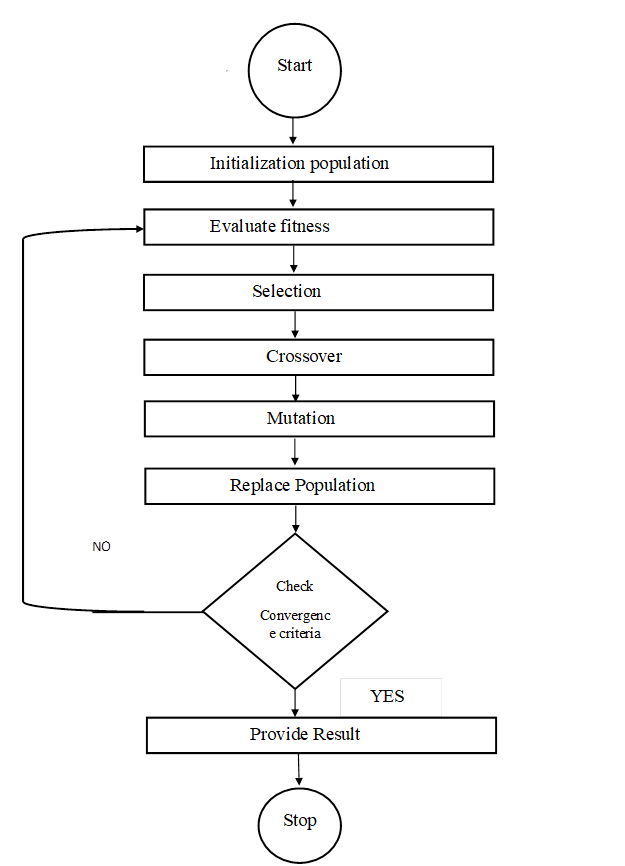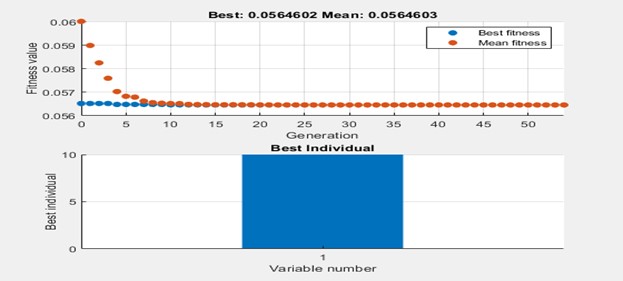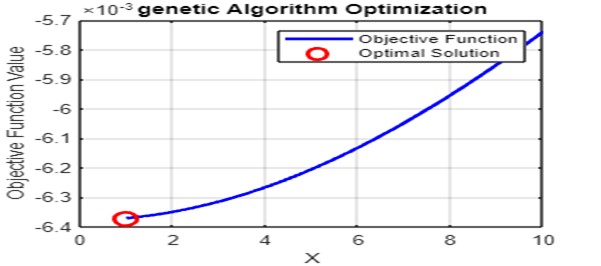Genetic Algorithm Optimization of Power Transfer Limit for Enhancement of Stability of Power System
- Aliyu Abubakar
- Mohammad Buhari Mohammad
- 523-529
- Jul 23, 2024
- Electrical Engineering
Genetic Algorithm Optimization of Power Transfer Limit for Enhancement of Stability of Power System
Aliyu Abubakar, Mohammad Buhari Mohammad
Department of Electrical and Electronics Engineering Technology Federal Polytechnic, Bali Taraba State
DOI: https://doi.org/10.51584/IJRIAS.2024.906046
Received: 05 June 2024; Revised: 13 June 2024; Accepted: 20 June 2024; Published: 23 July 2024
ABSTRACT
The work presents the Genetic Algorithm (GA) as an innovative method for optimizing power transfer limits to improve the stability of power systems. This is especially important given the increasing integration of renewable energy and the growing complexity of power networks. Traditional static threshold methods often lead to inefficiencies and instability during periods of high demand or fluctuating renewable generation. The GA tackles these challenges by representing potential solutions as chromosomes that evolve over successive generations through processes inspired by natural selection. These processes include initialization, fitness evaluation, selection, crossover, mutation, and replacement. The results of the genetic algorithm optimization indicate the optimal threshold value of 1.0564602 for the power transfer limit of the power systems. This dynamic adaptation ensures robust and efficient solutions, ultimately improving power transfer efficiency and meeting constraints to prevent overloads and voltage instability. Ultimately, the GA enhances overall power system performance by ensuring efficient and reliable operation in the face of modern challenges.
Keywords: Power transfer limits, Genetic Algorithm, Power system stability, Optimization, Power grid, Smart grid, Energy management, Renewable energy integration,
INTRODUCTION
The stability of power systems is crucial for ensuring the reliable operation of electricity grids (Setiadi & Jones, 2016). With the increasing integration of renewable energy sources and the complexity of modern power networks, maintaining stability becomes a challenging task. One key aspect of stability is managing the power transfer limits within the grid to prevent overloads and voltage instability (Sokolov et al., 2022). Traditional methods rely on predetermined thresholds, often set conservatively to avoid instability. However, these fixed thresholds may not always be optimal, leading to either underutilization of the grid or risking instability during peak demand periods (Xu et al., 2018). To address this challenge, novel approaches are being explored to dynamically determine the optimal threshold of power transfer limits. In this study, we propose the use of the genetic algorithm as a promising technique to adaptively optimize these thresholds in real-time, thereby enhancing power system stability (Nikzad et al., 2011). The genetic algorithm optimization is based on the principles of natural selection and genetic recombination. It mimics the process of natural evolution to search for the optimal solution to a problem (Khamees et al., 2017). In the context of power systems, the genetic algorithm optimization can be utilized to fine-tune the parameters of power transfer limits based on real-time grid conditions (. et al., 2019). This approach allows for the adaptation to changing load patterns, generation capacities, and network topology, while aiming to maximize grid utilization and stability (Farahani et al., 2011). By simulating the process of natural selection and genetic recombination, the algorithm iteratively explores and evaluates potential solutions, ultimately converging towards an optimal configuration that enhances power system stability (Zhao et al., 2013). Previous research has explored various approaches for enhancing stability in power systems, including optimization techniques, machine learning algorithms, and bio-inspired algorithms (Ray et al., 2018). Optimization techniques such as genetic algorithms and particle swarm optimization have been widely used to address different aspects of power system stability(Mokari-bolhasan et al., 2014). Machine learning algorithms have shown promise in predicting system behavior and optimizing control strategies(Hong et al., 2019)(Dash, 2018). Bio-inspired algorithms, such as the ant colony optimization algorithm, have been successfully applied to various optimization problems, including power system operation and control.(Mohanty, 2019)
1.1 The Objective Function Formulation of a Power Transfer Limit for Power System
Consider the case of power transmission over a lossless line. Let \( V_i \) and \( V_j \) be the sending end and receiving end voltages where \( \theta = \theta_i – \theta_j \) is the phase angle. \( R \) and \( X \) are the resistance and reactance, respectively. The real and the reactive power at the receiving end are given as (Zhu et al. 2018):
\[
P_j = \frac{V_i V_j}{R^2 + X^2} \sin \theta \quad \text{and} \quad Q_j = \frac{V_i V_j}{R^2 + X^2} \cos \theta – \frac{V_j^2}{R^2 + X^2} \quad \text{(1)}
\]
From equation (1) above using
\[
P_j = \frac{V_i V_j}{R^2 + X^2} \sin \theta
\]
\[
\frac{dP_j}{dV_j} = \frac{V_i \sin \theta}{R^2 + X^2} + \frac{V_i V_j \cos \theta}{R^2 + X^2} \frac{d\theta}{dV_j} = 0 \quad \text{(2)}
\]
\[
0 = \frac{V_i \sin \theta}{R^2 + X^2} + \frac{V_i V_j \cos \theta}{R^2 + X^2} \frac{d\theta}{dV_j}
\]
\[
\frac{sin \theta}{(R^2 + X^2)} = \frac{V_j \cos \theta}{(R^2 + X^2)} \frac{d\theta}{dV_j}
\]
\[
-\sin \theta = V_j \cos \theta \frac{d\theta}{dV_j}
\]
\[
\frac{d\theta}{dV_j} = \frac{-\sin \theta}{V_j \cos \theta} = \frac{-\tan \theta}{V_j} \quad \text{(3)}
\]
From equation (1) above using (Mokari-bolhasan et al. 2014)
\[
Q_j = \frac{V_i V_j}{(R^2 + X^2)} \cos \theta – \frac{V_j^2}{(R^2 + X^2)}
\]
\[
\frac{dQ_i}{dV_j} = \frac{V_i V_j \cos \theta}{(R^2 + X^2)} + \frac{V_i V_j \sin \theta}{(R^2 + X^2)} \frac{d\theta}{dV_j} – \frac{2V_j}{(R^2 + X^2)}
\]
\[
\frac{dQ_i}{dV_j} = \frac{V_i V_j \cos \theta}{(R^2 + X^2)} + \frac{V_i V_j \sin \theta}{(R^2 + X^2)} \frac{\sin \theta}{V_j \cos \theta} – \frac{2V_j}{(R^2 + X^2)}
\]
\[
\frac{dQ_i}{dV_j} = \frac{V_i V_j \cos \theta}{(R^2 + X^2)} + \frac{V_i V_j}{(R^2 + X^2)} \frac{\sin^2 \theta}{V_j \cos \theta} – \frac{2V_j}{(R^2 + X^2)}
\]
\[
\frac{dQ_i}{dV_j} = \frac{V_j (\sin^2 \theta + \cos^2 \theta)}{(R^2 + X^2) \cos \theta} – \frac{2V_j}{(R^2 + X^2)}
\]
\[
\frac{dQ_i}{dV_j} = \frac{V_j}{(R^2 + X^2) \cos \theta} – \frac{2V_j}{(R^2 + X^2)}
\]
\[
\frac{dQ_i}{dV_j} = \frac{V_j \sec \theta}{(R^2 + X^2)} – \frac{2V_j}{(R^2 + X^2)}
\]
\[
f(n) = \frac{V_j}{(R^2 + X^2)} (\sec \theta – \frac{2V_j}{V_i}) \quad \text{(4)}
\]
\[
f(n) = \sum_{J=1}^{J} \frac{V_j}{(R^2 + X^2)} (\sec \theta – \frac{2V_j}{V_i}) \quad \text{(5)}
\]
And the constraint of the above equation is given as (Falehi 2020):
\[
\theta_{\text{Min}} \leq \theta_i \leq \theta_{\text{Max}} \quad \theta_{\text{Min}} \leq \theta_j \leq \theta_{\text{Max}} \quad V_{\text{Min}} \leq V_i \leq V_{\text{Max}} \quad V_{\text{Min}} \leq V_j \leq V_{\text{Max}}
\]
METHOD
The process of implementing a genetic algorithm to optimize the power transfer limit of a power system begins with defining the problem parameters. This involves specifying the network topology, transmission line capacities, and operational constraints. Next, an initial population of candidate solutions needs to be generated, with each representing a different configuration of power flow within the network. The fitness of each solution is then evaluated, which involves calculating its ability to maximize power transfer while adhering to constraints such as voltage stability, thermal limits of transmission lines, and system reliability. The individuals with higher fitness scores are selected using methods like roulette wheel selection for reproduction, and crossover operations are applied to combine genetic material from selected parents. Mutations are also introduced to offspring to maintain diversity and explore new configurations. Less fit individuals in the population are replaced with newly generated offspring. The selection, crossover, mutation, and replacement processes are repeated until convergence criteria are met, which could be a set number of generations or a target power transfer limit. Finally, the configuration that achieves the highest optimized power transfer limit is returned.
Fig. 1 shows a flowchart of the genetic algorithm optimization for the power transfer limit of a power system.
RESULTS
The Genetic Algorithm (GA) has been proven to be highly effective in optimizing power transfer limits within the power system, resulting in significant improvements in system stability. The results of the genetic algorithm optimization indicate the optimal threshold value of 1.0564602 for the power transfer limit of the power systems. By successfully applying the GA, the study has underscored the potential of nature-inspired algorithms to address complex engineering challenges with efficacy. This achievement not only demonstrates the GA’s prowess in power systems but also suggests its broader applicability across various domains requiring optimization and stability enhancement. The successful outcome of this study highlights the transformative impact of leveraging nature-inspired algorithms in overcoming intricate engineering hurdles, thereby opening avenues for innovative problem-solving methodologies in diverse fields.
Figures 2 and 3 show the results of the genetic algorithm optimization for the power transfer limit of the power system.
Fig. 4: Graph depicting the optimal solution of the genetic algorithm optimization process with the optimal threshold value of 1.0.
DISCUSSION
The study’s findings suggest that the Genetic Algorithm (GA) can significantly improve the stability of power systems by optimizing power transfer limits. This approach shows promise in addressing stability issues within power systems, potentially leading to more robust and reliable energy distribution. Implementing the GA could help in proactively addressing and preventing stability concerns, contributing to the overall resilience and efficiency of power networks. The success of this application demonstrates the effectiveness of nature-inspired algorithms in solving complex engineering problems, with potential applications in other domains requiring optimization and stability improvements
CONCLUSION
The Genetic Algorithm (GA) shows promise as a tool for improving the stability of power systems by optimizing power transfer limits. Further research and practical application of this algorithm could lead to significant improvements in power system stability. The Genetic Algorithm offers a method for enhancing power system stability by dynamically determining optimal thresholds for power transfer limits. By using genetic principles and evolution-inspired processes, the algorithm adjusts thresholds in real-time to optimize grid utilization while ensuring stability. The study’s findings highlight the effectiveness of this approach in improving power system stability and resilience, paving the way for intelligent and adaptive strategies in managing power transfer limits within modern electricity grids.
REFERENCE
- F. A., S. H., & G. K. P. (2019). Optimization Techniques in Power System: Review. International Journal of Engineering Applied Sciences and Technology, 3(10), 8–16. https://doi.org/10.33564/ijeast.2019.v03i10.003
- Dash, K. S. R. S. S. (2018). Load frequency control of autonomous power system using adaptive fuzzy based PID controller optimized on improved sine cosine algorithm. Journal of Ambient Intelligence and Humanized Computing, 0(0), 0. https://doi.org/10.1007/s12652-018-0834-z
- Falehi, A. D. (2020). Optimal robust disturbance observer based sliding mode controller using multi ‑ objective grasshopper optimization algorithm to enhance power system stability. Journal of Ambient Intelligence and Humanized Computing, 0123456789. https://doi.org/10.1007/s12652-020-01811-8
- Farahani, S. S. S., Nikzad, M., Tabar, M. B., Naraghi, M. G., & Javadian, A. (2011). Dynamic stability enhancement and voltage support using upfc tuned genetic algorithms in a multimachine environment. International Journal of Physical Sciences, 6(22), 5273–5280. https://doi.org/10.5897/IJPS11.833
- Hong, Y., Member, S., & Nguyen, M. (2019). Multiobjective Multiscenario Under-Frequency Load Shedding in a Standalone Power System. IEEE Systems Journal, PP, 1–11. https://doi.org/10.1109/JSYST.2019.2931934
- Khamees, A. K., El-Rafei, A., Badra, N. M., & Abdelaziz, A. Y. (2017). Solution of optimal power flow using evolutionary-based algorithms. International Journal of Engineering, Science and Technology, 9(1), 55–68. https://doi.org/10.4314/ijest.v9i1.5
- Mohanty, B. (2019). Hybrid flower pollination and pattern search algorithm optimized sliding mode controller for deregulated AGC system. Journal of Ambient Intelligence and Humanized Computing, 0123456789. https://doi.org/10.1007/s12652-019-01348-5
- Mokari-bolhasan, A., Seyedi, H., Mohammadi-ivatloo, B., & Abapour, S. (2014). Electrical Power and Energy Systems Modified centralized ROCOF based load shedding scheme in an islanded distribution network. International Journal of Electrical Power and Energy Systems, 62, 806–815. https://doi.org/10.1016/j.ijepes.2014.05.029
- Nikzad, M., Farahani, S. S. S., Naraghi, M. G., Tabar, M. B., & Javadian, A. (2011). Voltage support and stability improvement using unified power flow controller tuned based on simulated annealing. International Journal of Physical Sciences, 6(20), 4781–4789. https://doi.org/10.5897/IJPS11.835
- Ray, P. K., Paital, S. R., Mohanty, A., Eddy, F. Y. S., & Gooi, H. (2018). A robust power system stabilizer for enhancement of stability in power system using adaptive fuzzy sliding mode control. Applied Soft Computing Journal, 73, 471–481. https://doi.org/10.1016/j.asoc.2018.08.033
- Setiadi, H., & Jones, K. O. (2016). Power system design using firefly algorithm for dynamic stability enhancement. Indonesian Journal of Electrical Engineering and Computer Science, 1(3), 446–455. https://doi.org/10.11591/ijeecs.v1.i3.pp446-455
- Sokolov, A. A., Fomenko, O. A., & Ignatev, I. V. (2022). Development of algorithms for control and control of electric power parameters based on information-measuring system data. Journal of Physics: Conference Series, 2176(1). https://doi.org/10.1088/1742-6596/2176/1/012076
- Xu, G., Cheng, H., Fang, S., Ma, Z., Zeng, P., & Yao, L. (2018). Optimal Size and Location of Battery Energy Storage Systems for Reducing the Wind Power Curtailments. Electric Power Components and Systems, 46(3), 342–352. https://doi.org/10.1080/15325008.2018.1445141
- Zhao, C., Topcu, U., & Low, S. H. (2013). Optimal load control via frequency measurement and neighborhood area communication. IEEE Transactions on Power Systems, 28(4), 3576–3587. https://doi.org/10.1109/TPWRS.2013.2261096
- Zhu, Y., Liu, C., Wang, B., & Sun, K. (2018). Damping control for a target oscillation mode using battery energy storage. Journal of Modern Power Systems and Clean Energy, 6(4), 833–845. https://doi.org/10.1007/s40565-017-0371-3



